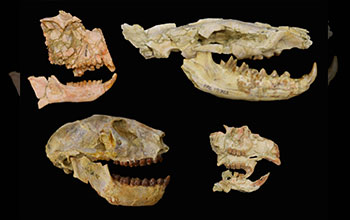Multimedia Gallery
Fossils from Egypt from key groups in Eocene-Oligocene extinction
Researchers discovered a previously undocumented extinction event that followed the transition between the Eocene and Oligocene periods and affected animals in Africa. Fossils from the Fayum Depression in Egypt from key groups in this extinction include: (upper left) Plesiopithecus, a lemur-like primate; (upper right) Masrasector, a carnivorous hyaenodont; (lower left) Parapithecus, a monkey-like primate; and (lower right) Gaudeamus, a guinea pig-like rodent.
[Research supported by U.S. National Science Foundation grants DBI 1612062, DBI 1458192, BSC 1824745 and DBI 2023087.]
Learn more in the Duke University news story The climate-driven mass extinction no one had seen. (Date image taken: Oct. 6, 2021; date originally posted to NSF Multimedia Gallery: April 13, 2022)
Credit: Matt Borths, Duke Lemur Center, Duke University
Images and other media in the National Science Foundation Multimedia Gallery are available for use in print and electronic material by NSF employees, members of the media, university staff, teachers and the general public. All media in the gallery are intended for personal, educational and nonprofit/non-commercial use only.
Images credited to the National Science Foundation, a federal agency, are in the public domain. The images were created by employees of the United States Government as part of their official duties or prepared by contractors as "works for hire" for NSF. You may freely use NSF-credited images and, at your discretion, credit NSF with a "Courtesy: National Science Foundation" notation.
Additional information about general usage can be found in Conditions.
Also Available:
Download the high-resolution JPG version of the image. (4.1 MB)
Use your mouse to right-click (Mac users may need to Ctrl-click) the link above and choose the option that will save the file or target to your computer.

 All images in this series
All images in this series